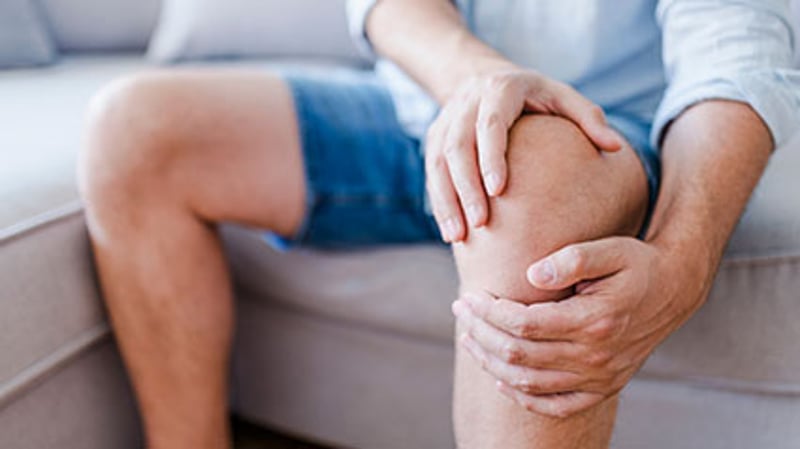Mon-Fri: 8:30a.m.-5:30p.m. | Sat: 9a.m.-12p.m. | Sun. & Major Holidays: Closed
Patient Resources
Get Healthy!
What Are the Major Types of Arthritis?
- April 17, 2023
- Sue Benzuly, RN
- HealthDay Reporter

Arthritis strikes millions of Americans, leaving them with aching, inflamed joints that make it hard to move around without pain.
It is the leading cause of disability and most common in women, but is it the same for everyone?
Absolutely not. There are over 100 different forms of arthritis and they aren't all treated the same, according to the Arthritis Foundation.
Here are the four main types of arthritis, and more about their differing symptoms and treatments:
- Osteoarthritis
- Autoimmune inflammatory arthritis
- Infectious (reactive) arthritis
- Gout (metabolic arthritis)
Osteoarthritis
The National Institute of Arthritis and Musculoskeletal and Skin Diseases (NIAMS) states that osteoarthritis is the most common type of arthritis, especially in older people. The tissues in the joint break down, and as the disease develops, it can damage the entire joint. The joints most commonly affected are:
- Hands (ends of fingers and base of the thumb)
- Knees
- Hips
- Neck
- Lower Back
Common symptoms of osteoarthritis are:
- Pain in the joint
- Joint stiffness
- Limited range of movement in the joint
- Swelling in and around the joint
- Feeling that the joint is loose or unstable
Treatments for osteoarthritis:
According to the Mayo Clinic, the following treatments for osteoarthritis cannot reverse the disease, but they can help reduce pain and improve movement:
- Acetaminophen (Tylenol).
- Nonsteroidal anti-inflammatory drugs (NSAIDs) such as ibuprofen (Advil, Motrin IB and others) and naproxen sodium (Aleve). Use caution with NSAIDs; long-term use can cause bleeding problems or liver and kidney damage.
- Duloxetine (Cymbalta) is an antidepressant also approved to treat osteoarthritis pain.
- Physical and occupational therapy may help manage arthritis.
- Transcutaneous electrical nerve stimulation (TENS) uses a low dose of electrical current and may provide short-term relief for people with osteoarthritis.
- Surgery and other procedures may be helpful.
- Cortisone or lubrication injections may help.
- Physical activity: According to Susan Bartlett, a professor of medicine in the division of rheumatology at Johns Hopkins' Arthritis Center in Baltimore, exercise helps. "Physical activity is essential to optimizing both physical and mental health, and can play a vital role in the management of arthritis," she noted in a recent article. "Regular physical activity can keep the muscles around affected joints strong, decrease bone loss and may help control joint swelling and pain. Regular activity replenishes lubrication to the cartilage of the joint and reduces stiffness and pain."
Autoimmune inflammatory arthritis
According to the Arthritis Foundation, when you have autoimmune inflammatory arthritis, the immune system attacks healthy tissue, including joints in the spine, hands and feet. It can become systemic, affecting the eyes, skin, heart and other organs. Rheumatoid arthritis is the most common form; there is also psoriatic arthritis, axial spondyloarthritis and juvenile arthritis.
Common symptoms of autoimmune arthritis are:
- Rheumatoid arthritis: Joint pain, tenderness, or stiffness that lasts longer than six weeks. Morning stiffness that lasts 30 minutes or longer. More than one joint is affected, and the same joints on both sides of the body are affected. Fatigue is also a symptom.
- Psoriatic arthritis: Itchy, painful, red patches or a silvery build-up of dead skin cells. Cracking, pitting and white spots on the nail bed. Fatigue, inflammation and swelling where tendons and ligaments connect with a bone.
- Axial spondyloarthritis: Pain and stiffness that starts gradually and lasts three months. The pain improves during exercise and stretching but worsens at rest -- morning stiffness.
- Juvenile rheumatoid arthritis: Swollen, stiff, painful joints, light sensitivity, rash, fatigue, hardened patches of skin.
Treatments for autoimmune inflammatory arthritis include:
- NSAIDs
- Corticosteroids
- DMARDs -- Disease-modifying anti-rheumatic drugs that reduce inflammation and prevent the worsening of the disease. Biologics and Janus kinase (JAK) inhibitors are special types of DMARDs.
- Surgery
- Physical and occupational therapy
Infectious (reactive) arthritis
NIAMS states that reactive arthritis occurs after a bacterial infection. The arthritis symptoms typically begin after recovery from the initial illness. The knee and ankle joints are frequently affected, as well as the lower back.
Symptoms include:
- Joint pain and stiffness, inflamed fingers or toes, pain in the heel or foot
- Morning stiffness
- Inflammation of the urinary tract after an infection of the urinary tract or genitals
- Eye inflammation
- Fatigue
- Fever
- Diarrhea and abdominal pain
- Ulcers in the mouth
- Skin rash
- Thickened nails
According to the Mayo Clinic, treatment typically includes:
- NSAIDs
- Steroid injections
- Rheumatoid arthritis medications
- Physical therapy
Gout
The U.S. Centers for Disease Control and Prevention defines gout as an extremely painful form of arthritis. Uric acid crystals build up in the affected joint, typically affecting one joint at a time, usually the big toe. It can go into remission or flare up. Untreated, it can lead to gouty arthritis.
Symptoms of gout in the affected joint are:
- Intense pain
- Swelling
- Redness
- Heat
Treatment for gout includes:
- NSAIDs
- Limit purine-rich foods (the body breaks them down into uric acid), such as red meat or organ meat
- If possible, change or stop medications associated with hyperuricemia (high uric acid levels in the blood)
- Medications to lower uric acid levels, including allopurinol, febuxostat and pegloticase

